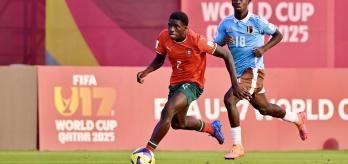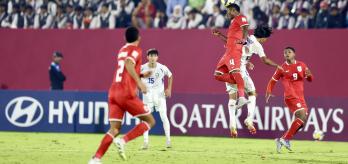These runs mostly occur in the space between the defending team’s widest defender and the closest centre-back, from an attacking player who starts the run from a deeper position. The aim of the run is to offer to receive in behind the opposition’s defensive line but inside their team shape, the space that defending teams most want to defend.
In the opening 96 games of FIFA U-17 World Cup 2025, 24 goals contained this run in the sequence of events leading to the goal. Compared to 2023, more of these runs are being made, and more are now leading to goal attempts and goals. As can be seen in graphic 2 below, Portugal have generated the most success from this, with the highest volume of attempts at goal and goals scored from this action per 30 minutes in possession.
As a former left-winger, this is a run that TSG expert Damien Duff advocates for due to the disruption and confusion it can cause to the opponent’s defensive structure.
“It’s a gear-changing move that leaves defenders wondering who to pick up, especially if the run is not tracked and the nearest defenders are already occupied by other attackers. All top teams are relentless in making this run, and it can be made by anyone. Many goals you see in top-level football have this run because it stresses opponents and puts defenders in no-win situations.”
Key points
-
The timing is crucial to ensure the runner is not too early/offside when the pass is played through
-
Runners should make blindside or opposite-side runs behind defenders and out of their line of sight
-
The weight and shape of the pass should allow the runner to receive on the front foot and in stride
-
The run can be used as a decoy to draw a defender to the runner, vacating space that can be exploited
For Duff, this run causes problems when it isn’t tracked, but also when it is tracked, highlighting the disruption it causes.
“In this tournament, we are seeing how some players are making the runs, and the run is followed, but the pass is still played, so they can receive on the front foot in behind the defensive line. If a centre-back tracks the runner, it opens the central channel, and if a centre-midfielder tracks, then it can be used as a decoy to open space in front of the defence. If no one tracks the run, then it’s a winning ball.”
Timing the run and the pass
While these runs can be made by any player and from anywhere, the timing is important. First, the runner must ensure they do not breach the defensive line too early and drift offside or run too late and miss the pass. Second, the player in possession must be aware of the run and time the pass to ensure the release of the ball before/as the defensive line is broken.
As Duff explains, “The timing and weight of the pass are important, as well as the shape of it. The passer needs to think about where they are playing from and whether the receiver is right-footed or left-footed. They need to decide whether to pass the ball with the inside or outside of their foot to get the right shape on the pass for the receiver to receive in stride to generate maximum speed in the attack.”
Commiting defenders to open inner channel
When a player in a wide channel who has the ball drives towards the opposition’s widest defender, they engage that defender by forcing them to commit to the 1v1 situation. This action can separate the defender from their team’s defensive structure, opening a gap between them in the inner channel. When a defender is engaged, their body shape is solely focused on the attacker and the ball, meaning any run into the inner channel will be out of their line of sight.
Duff elaborates on this by saying, “Blindside runs into the inner channels cause chaos, and for me, they are the best attacking runs in football. As an attacking player, if you see one of your players has a full-back engaged in a wide area and one of your forwards has the nearest centre-back pinned, or they hold their line protecting the central space, then runs into that inner channel are absolute gold.”
The decoy
The inner channel run can also be used as a decoy, especially when the run is tracked by an opposition player. If the wide defender is engaged and the gap in the inner channel opens for a runner from midfield, it is often the responsibility of a midfielder from the defending team to track this run. If this happens on the ball side, the space vacated by the defensive midfielder, who is tracking the runner, opens up.
As Duff notes, this is extremely disruptive to the opposition’s defensive structures.
“Wide defenders must commit to the 1v1s in the wide areas, and the defensive structure wants to protect the central space. If a run into the inner channel gap is tracked by the nearest centre-midfielder, a gap opens centrally, and any winger who loves to dribble or run with the ball will want to attack that space, especially if their forwards have the opposition centre-backs pinned in.”















